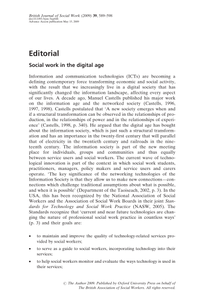Vergelijkende Europese studie in opdracht van Kees van Aken, toenmalig directeur van de opleiding Social Work i.o. van de Hogeschool Zuyd, naar welke verschillende varianten er mogelijk zijn als er gesproken wordt over een Internationale Bachelor Social Work - Maastricht. Op welke manieren zijn er in Europa reeds internationale bachelors zijn ontwikkeld. Het onderzoek moet een overzicht van enkele blauwdrukken van een Internationale Bachelor Social Work opleveren, om mede op basis daarvan een keuze te maken voor een (eventueel meerdere) voor Hogeschool Zuyd wenselijke variant(en) daarvan in Maastricht. Er is vergelijkend Europees onderzoek gedaan naar de verschillende filosofieën en organisatievormen van curricula International Social Work zoals die op verschillende Hogescholen en Universiteiten in Europa functioneren. Met name zijn “good practice” ervaringen onderzocht en met elkaar vergeleken, om op basis daarvan een aantal varianten helder te krijgen voor de opdrachtgever.
DOCUMENT

Een bezinning op de identiteit en de positie van het Instituut voor Social Work van Hogeschool Utrecht.
DOCUMENT

Inleiding op een themanummer van British Journal of Social Work over sociaal werk in de digitale samenleving.
DOCUMENT

To understand under what conditions intercultural group work (IGW) leads to more intercultural interactions, a survey was conducted among local students (n = 80) and international students (n = 153) in Dutch universities. In this study, students were more inclined to engage in intercultural interactions when they perceived that working with culturally diverse others prepared them to work and live in a diverse setting. The positive association was strengthened when students perceived that diversity, in terms of nationality within their work group, was also beneficial for accomplishing their group task. The findings demonstrate the significance of students’ perceptions of IGW, including the perceived general value for personal development and intellectual benefits related to specific tasks. This implies that institutions and teachers could be made responsible for engaging with innovative educational methods to address and incorporate student diversity into curriculum.
MULTIFILE

Article about social work and social policy in the Netherlands. It gives information about the background, history, the meaning of the profession and the different types of professional areas in which the profession is divided. Other subjects are: social work curricula, the European dimension of social work an current challenges for social professionals in the Netherlands.
DOCUMENT

In het werkveld van sociaal werkers wordt al volop gewerkt met ervaringsdeskundigen. Om toekomstige sociaal professionals hierop voor te bereiden, mag ervaringskennis niet ontbreken in het curriculum van de social work-opleiding. De behoefte onder docenten en studenten is er. Echter de inbedding gebeurt mondjesmaat. Hoe kan het onderwijs zich tot dit thema verhouden en wat is de beste aanpak? Sonja Liefhebber spreekt met de leden van de themawerkgroep Ervaringsdeskundigheid in het onderwijs, van Werkplaatsen Sociaal Domein. Onlangs voerde de werkgroep een inventarisatie uit onder 19 hogescholen social work.
LINK
The aim of this exploratory study was to assess whether practicing social workers currently enrolled in Master Social Work (MSW) programs (hereafter referred to as MSW students) were more oriented to the evidence-based practice (EBP) process and more engaged in it than practicing social workers who are not currently enrolled in MSW programs (hereafter referred to as social workers) in the Netherlands. Data were collected from MSW students (n = 32) and from social workers (n = 341) using the EBP Process Assessment Scale. MSW students reported a stronger orientation toward the EBP process, more positive attitudes toward EBP, more familiarity with EBP and more intentions to engage in EBP than social workers did, however, they were less positive about the feasibility of implementing EBP in practice. These preliminary results suggest that there are grounds for optimism about MSW students’ acceptance of and engagement in the EBP process. Implications for social work education are discussed.
DOCUMENT

Article about social work and social policy in the Netherlands. It gives information about the background, history, the meaning of the profession and the different types of professional areas in which the profession is divided. Other subjects are: social work curricula, the European dimension of social work an current challenges for social professionals in the Netherlands.
DOCUMENT

Boekbespreking van 'Social work: een constructieve benadering'
DOCUMENT
